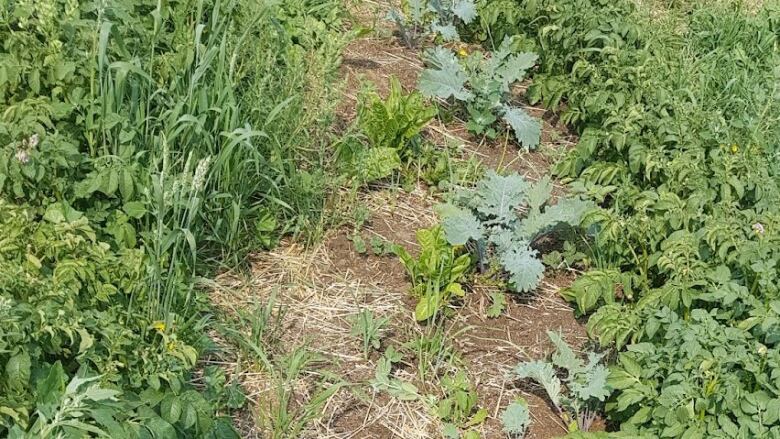Efficient or resilient: Alberta must find the right balance to protect our food supply
Heat dome illustrated the fragility of mainstream farming, writes researcher
This column is an opinion by farmer and researcher Tatenda Mambo. For more information about CBC's Opinion section, please see the FAQ.
Last summer, a brutal heat dome knocked out crops across the prairies. But on our experimental farm just south of Calgary, it also gave a measure of hope.
At the University of Calgary's Simon Farm Project near Blackie, Alta., we're testing whether the traits found in locally-saved and traditional seed varieties can bring more resilience to our food production in the face of climate change.
It's part of a larger research effort to help Alberta's farmers shift their practices and weather the increased drought we know is coming.
The heat showed a difference between the various seed varieties we were testing, and it was staggering.
Most potatoes, kale and other plants from the seed of national distributors succumbed to the heat and withered away. The same plants from the locally-saved seed held on.
This seed was from farmers in the region who had been planting and gathering it for at least 10 years, letting it acclimatize to our conditions. At the end of the day, despite four weeks of no significant rain and 27 C heat, we still got a modest harvest from the locally-acclimatized seed.
Of course, this is just one extreme summer and the work is ongoing, but the resilience of local seeds has been documented by other researchers. Traditional or Indigenous agricultural practices around the world have shown we can work with nature to produce our food in a manner that can restore and support ecological functions rather than degrade and erode them. And if we go back to incorporate these techniques, we can create a system that is more resilient.
Efficient or redundant
Recent events such as COVID-19, the 2021 drought, and the effects of the atmospheric rivers in B.C., shine a light on the fragility of our food systems. We saw simultaneous food dumping and supply disruptions, lost crops, and increased need for emergency food services.
This is because within our food system and rippled throughout society is an inherent tension between efficiency (streamlined approaches to doing things) and redundancy (multiple approaches to doing things). This impacts resilience.
You need the right balance between these two elements to create sustainable systems. Too much efficiency and the system becomes brittle, with disruptions causing system failures that have difficulty rebounding. Too much redundancy causes stagnation.
403 varieties of peas
Simon Farm is one of several efforts to learn how to bring resilience back into our food systems in ways that are ecologically sound and, eventually, commercially competitive.
With seeds, for example, the traditional practice of planting and harvesting seed meant farmers used to have many varieties of a single crop. For example, there used to be over 403 varieties of peas and today we only find 25. This has reduced resilience, but many farmers buy seed from distributors because it's easier and normally more cost effective.
On Simon Farm, we also increase the diversity of plants that we grow together. Rather than planting one crop per bed, our beds are filled with a mix of plants selected to support the overall growth and success of the beds. Together, they deter pests, enhance soil fertility, reduce compaction, shade the bed to conserve moisture, or fix nitrogen.
This diversity in crops is less efficient, but it enables resilience in both the short and long term.
We rotate annual crops suited to our climate, and have perennial crops such as sunchokes, asparagus and sorrel. The produce is donated to the High River Food Bank.
Wide adoption still a dream
The next major step for the farm is a passive solar greenhouse to enable vegetable production into the winter months, when the need for fresh produce is highest locally. Unlike much of the greenhouse industry in Alberta, it will largely depend on the sun for heat during the winter, and will tap low grade geothermal energy to regulate temperature extremes.
The truth is climate change will bring both challenges and opportunities to our agricultural sector. In some ways, it will no longer be prudent for our food system to cheaply provide us whatever we want to eat, regardless of the season.
But Alberta has untapped resources that can strengthen regional food production and leverage skills and infrastructure already present. Already, we have great examples of farmers working to restore the soil and being supported by customers buying their products directly. The Blue Mountain Biodynamic Farms in Carstairs, Alta., is one good example. Other organizations such as YYC Growers and Organic Box distribute locally-produced food to clients year-round. Local greenhouse operators are already using geothermal heat, and there's huge potential to use excess heat from repurposed orphan wells or industrial activities.
The tools are there. But while we have innovators in this field, we are a ways off from wide scale adoption. Government policies focused on export, the current supply chain and even crop insurance, are still all skewed toward conventional practices that fail to account for the problems they create, leaving our system fragile.
We need to recognize that change is coming. The question is whether we will lead it or be victims of it.
CBC Calgary: The High Cost of Food
CBC Calgary is using community insight to help understand the gaps in Calgary's food system. Add your cell phone number to share tips on saving money and help document how the high cost of food is changing the way we eat and shop. Read the series at cbc.ca/costoffood.



No comments:
Post a Comment